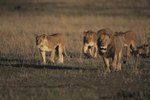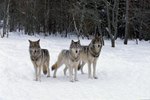
Wolves are social animals and they instinctively form packs, either with family members or nonrelated wolves living close by. A typical wolf pack in the wild consists of between 8 and 15 members. There is a distinct pecking order to any wolf pack. This order is important to the effective function of the pack as it determines leadership, division of labor and mating priorities.
Alpha Male
The alpha male is the boss. He eats first, has his pick of mates, and leads the pack during hunts and when dealing with threats to survival. An alpha male typically will select a mate from within the pack to whom he remains paired, although he may elect to separate from his mate and mate with a different female. The alpha male rarely has cause for aggression or violence toward subordinate wolves, instead asserting his dominance through a series of ritualized gestures, such as the alpha roll, scruff shaking and staring. When challenged for top position by a young pretender, the alpha male either will concede immediately or fight to retain his position, depending on his age and health. When the alpha male dies or is driven from the pack, the next most dominant male assumes his position.
Alpha Female
The alpha female may not be the most dominant female in the pack to begin with. Her seniority is achieved through her association with the alpha male. If the alpha male and the most dominant female are related closely, the alpha male typically bypasses her and selects a mate from lower in the pack. This mate then becomes part of the alpha pair and is given due deference from the rest of the pack.
Beta Wolves
Some packs, particularly large ones, have a “second-in-command” that is from outside of the alpha pair. This role typically is assumed by a male, but it also can be a female wolf. In smaller packs, there is no distinct beta, just the alpha pair, their subordinates who establish seniority among themselves, and the runt.
Omega
The omega is the most subordinate member of the pack, this wolf typically was the runt of the litter, and has grown up to be weaker and smaller than the rest. Wolves occupying this lowly position are not shamed or striving to rise up the ranks, they simply rank lowest, typically due to size and strength. The beauty of lupine and canine dynamics is that the pecking order is respected for its social benefits. Fights and squabbles rarely occur as each member knows its place. Only when new members arrive does the ritualized aggression to establish rank occur. In some cases, the omega wolf will be driven from the pack if he consistently challenges senior wolves, or if he is of little use in the hunt or when protecting resources, such as territory or food.
The Rest of the Pack
Between the alpha pair and the omega the wolves establish order among themselves. These wolves wait their turn to feed, may leave the pack to find a mate and typically follow the actions of the top wolf.
References
Photo Credits
-
Tom Brakefield/Stockbyte/Getty Images
Writer Bio
Simon Foden has been a freelance writer and editor since 1999. He began his writing career after graduating with a Bachelors of Arts degree in music from Salford University. He has contributed to and written for various magazines including "K9 Magazine" and "Pet Friendly Magazine." He has also written for Dogmagazine.net.




